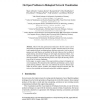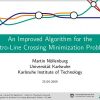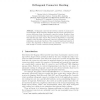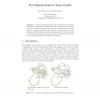GD
2009
Springer
14 years 10 months ago
2009
Springer
Abstract. The study of (minimally) rigid graphs is motivated by numerous applications, mostly in robotics and bioinformatics. A major open problem concerns the number of embeddings...
115
click to vote
GD
2009
Springer
14 years 10 months ago
2009
Springer
Much of the data generated and analyzed in the life sciences can be interpreted and represented by networks or graphs. Network analysis and visualization methods help in investigat...
114
Voted
GD
2009
Springer
15 years 4 months ago
2009
Springer
We show that recognizing intersection graphs of convex sets has the same complexity as deciding truth in the existential theory of the reals. Comparing this to similar results on t...
GD
2009
Springer
15 years 4 months ago
2009
Springer
We describe an algorithm for radial layout of undirected graphs, in which nodes are constrained to concentric circles centered at the origin. Such constraints are typical, e.g., i...
GD
2009
Springer
15 years 5 months ago
2009
Springer
Canonical ordering is an important tool in planar graph drawing and other applications. Although a linear-time algorithm to determine canonical orderings has been known for a while...
GD
2009
Springer
15 years 5 months ago
2009
Springer
Recently, we have presented a new practical method for upward crossing minimization [4], which clearly outperformed existing approaches for drawing hierarchical graphs in that resp...
GD
2009
Springer
15 years 5 months ago
2009
Springer
Abstract. Orthogonal connectors are used in a variety of common network diagrams. Most interactive diagram editors provide orthogonal connectors with some form of automatic connect...
GD
2009
Springer
15 years 5 months ago
2009
Springer
We show that each quadrangulation on n vertices has a closed rectangle of influence drawing on the (n − 2) × (n − 2) grid. Further, we present a simple algorithm to obtain a...
102
click to vote
GD
2009
Springer
15 years 5 months ago
2009
Springer
To produce high quality drawings of graphs with nodes drawn as shapes it is important to find routes for the edges which do not intersect node boundaries. Recent work in this area...





